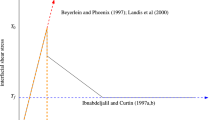Abstract
A theoretical analysis, previously developed to deal with the machanics of matrix cracking in unidirectional composites and with transverse ply cracking in cross ply laminates, has been developed further to deal with the tensile failure of unidirectional fibrous composites in with the fibres have a known distribution of strengths. It is proposed that, under the application of a tensile load, stable transverse cracks are formed which originate from regions of initial damage and which become unstable at some critical strain value. The model takes account of various parameters including the interfacial fibre/matrix debonding energy, the residual frictional shear strength of the debonded interface and the elastic properties of fibres and matrix. Comparisons are made between the predictions of the model and the observed failing strains of the 0° plies in carbon fibre polymer matrix laminates. The relevance of the model to the study of delayed fracture in fibrous composites is discussed. The modification of this model, previously developed to describe crack growth in the transverse plies of 0°/90° laminates, is used to predict the initial cracking strains for a wide range of CFRP laminate geometries and initial crack sizes. Some aspects of the mechanics of crack extension across interply interfaces are discussed.
Similar content being viewed by others
References
I. R. McColl andJ. G. Morley,Phil. Trans. Roy. Soc. Land. 287 (1977) 17.
Y. Korczynskyj, S. J. Harris andJ. G. Morley,J. Mater. Sci. 16 (1981) 1533.
Y. Korczynskyj andJ. G. Morley,ibid. 16 (1981) 1785.
G. A. Cooper andJ. M. Sillwood,ibid. 7 (1972) 325.
A. A. Griffith,Phil. Tram. Roy. Soc. Lond. A221 (1920) 163.
J. Aveston, G. A. Cooper andA. Kelly, “The properties of fibre composites”, Conference Proceedings, National Physical Laboratory, November 1971 (IPC Science and Technology Press, London, 1971) p.15.
J. E. Bailey, P. T. Curtis andA. Parvizi,Proc. Roy. Soc. Lond. A366 (1979) 599.
J. G. Morley, 3rd Riso International Symposium on Metallurgy and Materials Science, Fatigue and Creep of Composite Materials, September 1982, edited by H. Lilholt and R. Talreja (Riso National Laboratory, Roskilde, Denmark, 1982) p. 89.
P. W. Barry,Fibre Sci. Technol. 11 (1978) 245.
K. L. Reifsnider, 3rd Riso International Symposium on Metallurgy and Materials Science, Fatigue and Creep of Composite Materials, September 1982, edited by H. Lilholt and R. Talreja (Riso National Laboratory, Roskilde, Denmark, 1982) p.125.
Author information
Authors and Affiliations
Rights and permissions
About this article
Cite this article
Morley, J.G. Some aspects of crack growth and failure in fibre reinforced composites. J Mater Sci 18, 1564–1576 (1983). https://doi.org/10.1007/BF01111979
Received:
Accepted:
Issue Date:
DOI: https://doi.org/10.1007/BF01111979




